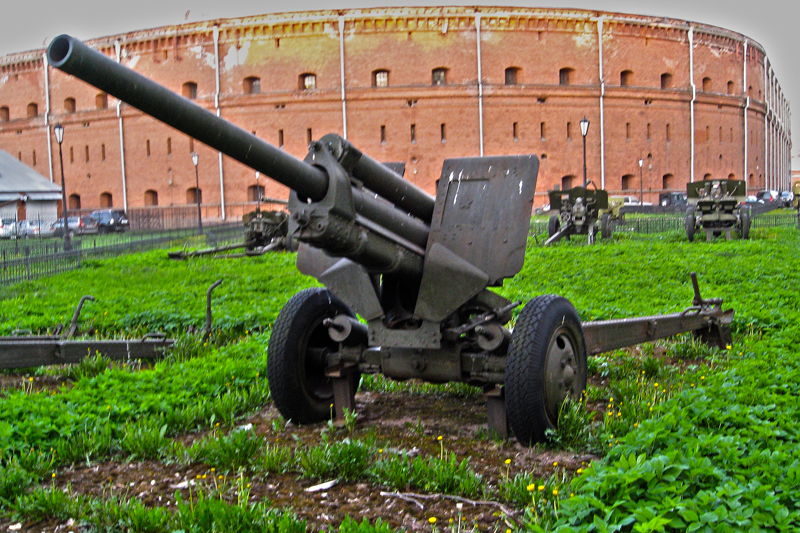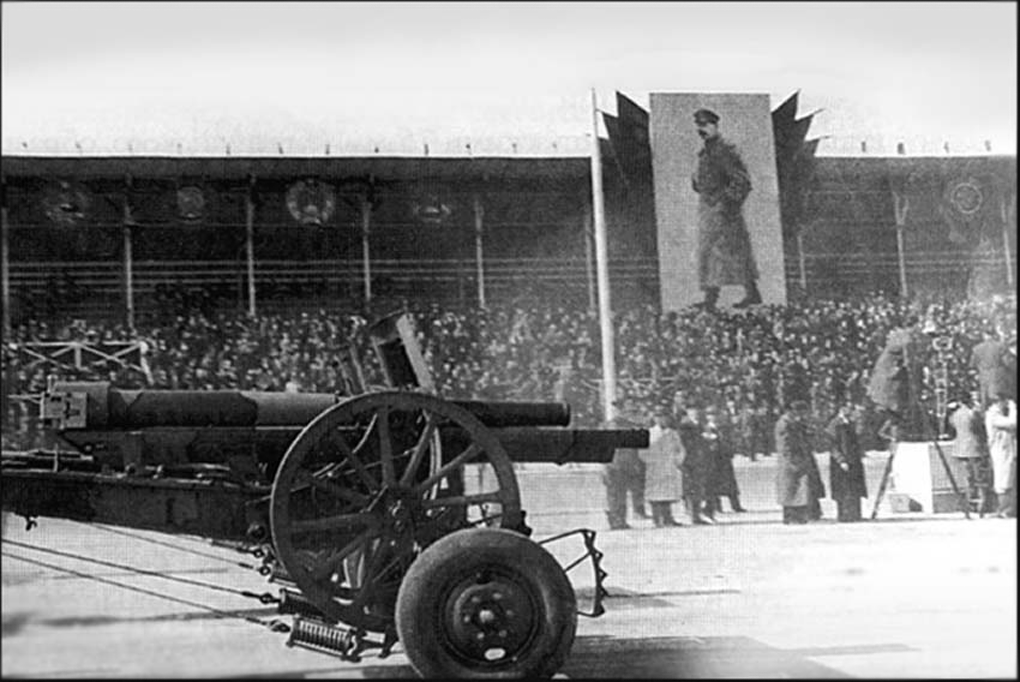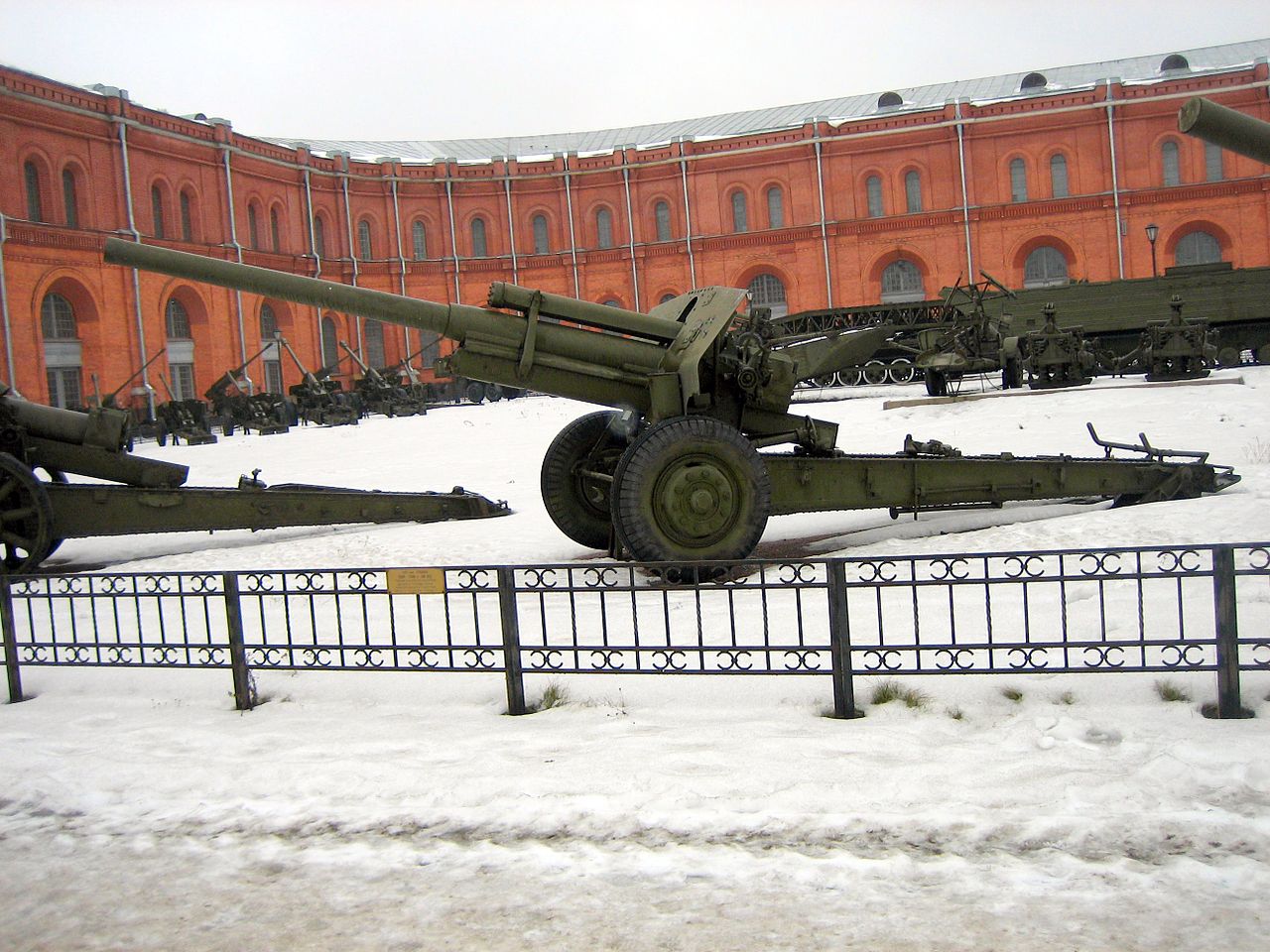The Book of Armaments:
Soviet 107mm Field Guns
by Mike Bennighof, Ph.D.
May 2021
 The Artillery Directorate of the Red Army of Workers and Peasants was well aware that the 76.2mm field guns of its light artillery battalions were out-classed by the 105mm howitzers deployed by the Germans and Americans in their similar units, and even by the 100mm howitzers the Poles and Romanians were deploying to re-arm their own light artillery. The Artillery Directorate of the Red Army of Workers and Peasants was well aware that the 76.2mm field guns of its light artillery battalions were out-classed by the 105mm howitzers deployed by the Germans and Americans in their similar units, and even by the 100mm howitzers the Poles and Romanians were deploying to re-arm their own light artillery.
On the other hand, the Red Army possessed massive stocks of 76.2mm ammunition, and the plant to produce more of it. Through the 1920’s and 1930’s, given the Soviet Union’s limited industrial capacity, this dictated the retention of the 76.2mm gun. But the Second Five-Year Plan provided new factories and machine tools, which meant that the old limits could be shrugged off.
In late 1937 the Red Army’s Artillery Directorate decided to upgrade divisional artillery with a new 95mm piece. The project began early the next year, with renowned designer V.G. Grabin of Plan No. 92 producing the winning entry. His 95mm F28 field gun used the same carriage as the newly-adopted 122mm F25 howitzer. It passed its trials, with good range, explosive power and anti-tank performance. A tank-mounted version, the F29, never made it off the drawing board but was considered for upgraded versions of the T28 medium and T35 heavy tanks.

The 95mm F28 prototype.
As promising as the F28 seemed, the Artillery Directorate decided to go with a 107mm weapon, as the Red Army already had such a cannon in service with a large stockpile of ammunition for it. The 107mm Model 1910 was based on a French Schneider design, with some imported before the Great War and others manufactured at the Obukhov Works during the course of the conflict. In 1930 the Directorate began a program to modernize the old guns as the Model 1910/30.
The Model 1910/30 had the virtue of relatively light weight, which allowed it to be drawn by horses or by trucks as well as dedicated prime movers. When new it had had very good range, but other weapons had surpassed it in the intervening years. Like other artillery pieces of its vintage, it lacked a high muzzle velocity, and Marshal G.I. Kulik demanded a heavy anti-tank gun that could defeat the expected German heavy tanks with thick armor.

Bolsheviks bombard Kronstadt with a Model 1910 107mm field gun, 1919.
Despite extensive modernization, the Model 1910/30 could not fill that role. The barrel was replaced with a longer tube, the breach also replaced, a muzzle brake added and new ammunition provided. The gun’s range increased from 12,000 to 16,000 meters, but it retained its old carriage which limited its angle of elevation and horizontal adjustment, and the speed at which it could be towed.
Production began in 1931 at the Bolshevik Plant in Leningrad (the former Obukhov Works, where most of the guns had originally been manufactured), moving to Stalingrad’s massive Barrikady factory complex in 1933. A total of 352 new guns had been manufactured when the project stopped in 1935, with another 510 of the old Model 1910 modernized to Model 1910/30 standards. In addition, four guns (it’s unclear whether these were new or modernized) were lost in action with the Japanese at Nomonhan in 1939.
The Model 1910/30 served as in corps artillery regiments in 1941 rather than as a divisional gun. When the rifle corps were abolished in September, the battalions shifted to Stavka Artillery Reserve (RVGK) cannon regiments. They remained in action throughout the Great Patriotic War.
Work on a replacement began in the fall of 1938, just as the 95mm F28 cannon began testing. V.G. Grabin of Plant No. 92 once again entered a design, but its prototype failed most of its tests – though it did display outstanding armor penetration. Given Kulik’s mania for anti-tank performance, Grabin had designed an enlarged version of the ZiS-2 high-velocity anti-tank gun, with an extremely long barrel that made the weapon difficult to manage.

A Model 1910/30 parades through Riga on its nifty travel trailer, sometime in 1940.
The winning entry came from Grabin’s great rival, Fedor Petrov of Plant No. 192 in Perm. Petrov had designed the Red Army’s new 122mm and 152mm howitzers (and later would create the 85mm DT5 tank cannon and the Soviet Union’s first anti-tank missile). A first round of tests in April 1940 revealed a number of flaws, which Petrov corrected before submitting a new prototype in October. This time the weapon passed all of its field tests, and was adopted for serial production as a corps rather than a divisional gun, to replace the Model 1910/30 in its current role.
Grabin, meanwhile, received a commission from Stalin himself to revive his own 107mm project, as a tank gun to equip a new model of the KV-1 heavy tank. Grabin drafted a tank-mounted version, labelled the ZiS-6, that borrowed some features from Petrov’s cannon. The KV-5 began as an effort to upgrade the armament of the KV-1, but evolved into a new tank design using as many KV-1 components as possible. The German invasion of June 1941 ended design work, and the prototype was never completed, but the ZiS-6 cannon underwent testing in a modified KV-2 heavy artillery tank. Serial production began in July 1941, but stopped after five guns had been completed when it became obvious that there would be no tank in which to mount them.

Testing the 107mm ZiS-6.
Petrov’s field gun was large and heavy, but it did offer splendid performance in terms of range and accuracy. It was not particularly mobile, and would not have served well as a divisional gun. After Plant No. 192 produced eleven pre-production models the work shifted to Plant No. 352 in Novocherkassk, just outside of Rostov. That factory had turned out 127 more guns when work shut down in November 1941 as the German invaders approached. Soviet resistance stiffened and the Germans didn’t actually occupy the factory until July 1942, but the workers were unable to evacuate their machine tools and other equipment and production could not be moved to another plant. After the fascist scum were kicked back out in February 1943, the factory and its assembly lines were judged too badly damaged to bring into service.

A 107mm Model 1940 field gun at the St. Petersburg Artillery Museum.
The Model 1940 was a marked improvement over the Model 1910/30, with superior range from a much lighter weapon. The Red Army judged it too heavy to be drawn by trucks and horses, which relegated it to corps- and army-level artillery regiments, but it probably could have been pulled by either means if necessary. It had outstanding anti-tank performance, and some guns saw action in that role at Kursk in 1943.
But it was an expensive weapon to produce, requiring skilled labor, and a complicated one to operate, requiring a well-trained crew. The Artillery Directorate didn’t consider the effort to re-establish a production line worthwhile with other more useful weapons in production. The existing guns saw action until the end of the Great Patriotic War, but no new examples joined them or replaced losses.
You can order The Book of Armaments Vol. One right here.
Please allow an additional three weeks for delivery.
Sign up for our newsletter right here. Your info will never be sold or transferred; we'll just use it to update you on new games and new offers.
Mike Bennighof is president of Avalanche Press and holds a doctorate in history from Emory University. A Fulbright Scholar and NASA Journalist in Space finalist, he has published eleventy-million books, games and articles on historical subjects.
He lives in Birmingham, Alabama with his wife, three children and his dog Leopold.
Want to keep Daily Content free of third-party ads? You can send us some love (and cash) through this link right here.
|
